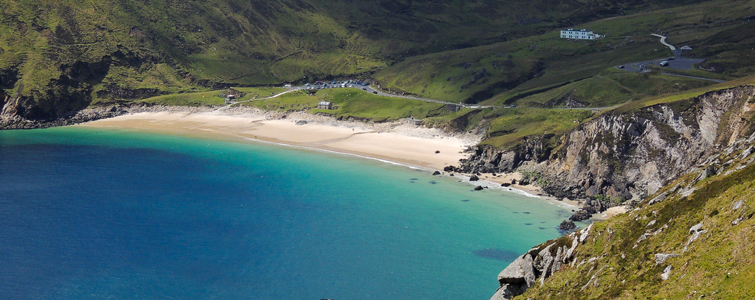The Mysterious and Forgotten Village, Achill in Co. Mayo

Keem Bay is one of the most iconic breathtaking views on Achill Island.
It was traditionally used by fishermen and is probably the location of the artist Paul Henry's famous painting 'Launching the Currach' (1910, on display in the National Gallery of Ireland).
It is a magnificent rural and sheltered beach at the head of a valley between the cliffs of Benmore to the West and Croaghaun Mountain on the East.
This valley is nice and wild; a little road climbs up till an early 20th-century coastguard station. At short way from this building the ground shows strange lumps and bumps in the grass. This is the site of a mysterious village which was inhabited until 1838.
There is no local memory of it, but some accounts, left by travel writers visiting the Protestant Achill Mission, give important clues about the site, even though describing the local people as primitive and backward. In addiction an old Ordinance Survey map, made in 1838, shows the cluster of small buildings that made up the village. The map shows small brown rectangles scattered across an area of about 250 m by 150 m near a small stream. A recent research by the Achill Archaeological Field School discovered more about this forgotten village.
The houses were simple dwellings, nothing more than one single room with a stout earth, drystone walls around 1 m thick and rounded corners. The roofs were thatched with heather or straw. There were a single door faced south-west looking to Moyteoge Head and Clew Bay and no chimney or fireplace. The fire sat directly on the earthen floor and probably the smoke would have wafted up through the roof. It is thought the practice of keeping cattle in the house in wintertime was popular among the villagers here as in the whole West of Ireland during the 19th century.
Archaeologists found a large number of broken pottery including fine glazed English earthenwares, some cream coloured plates edged with vivid blue and green impressed shell design, milk jugs striped in brown and black and some bright orange and pink glazed vessels. This proves that inhabitants of the mysterious village adorned their homes.
Also three glass beats from a rosary and pieces of violet amethyst crystal were found in the houses. It is thought the violet amethyst crystals came from a nearby quarry and the village people used to sell them to early nineteenth-century tourists.
The end of the village is uncertain; the Great Irish Famine of the 1840s may have caused the abandonment of the village.
In addition there is clear evidence the houses were intentionally demolished and their stones carried off. Charles Boycott who acquired the lease of Keem in 1855 from Murray McGregor Blacker, a tenant of the Achill Mission, built a house overlooking the village and is thought to be the person responsible for this demolition.
Further investigations will continue.
